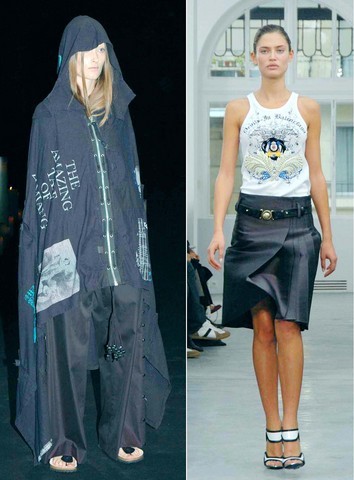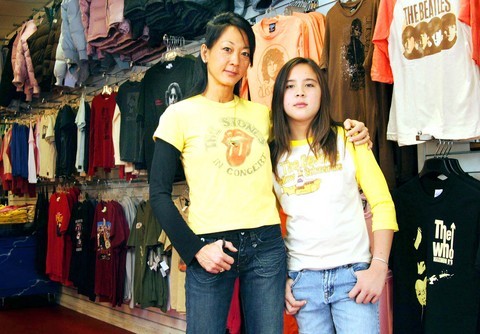Deborah Dejah, a New Yorker and the mother of two, has long shared her daughter's tastes in music. Now she shares her dress size too. So it was probably inevitable that Dejah, 48, and Olivia, 14, would find themselves at Marsha D.D., a Third Avenue store in New York specializing in children's fashion, squeezing their diminutive frames into identical Doors T-shirts, the image of Jim Morrison emblazoned on the front.
The Dejahs' infatuation with the accouterment of classic rock 'n' roll does not stop there. Olivia makes regular forays into her mother's closet, ferreting out the old T-shirts, frayed jeans and weathered cowboy boots that were once the emblems of her mother's renegade look, hoping they will lend a subversive edge to her own.
Deborah Dejah is thrilled. "These clothes resonate from your childhood," she said. "That you could share them with your kid is really wonderful."

PHOTOS: NY TIMES
It is also fashionable, perfectly in tune with the current revival of an old-school aesthetic founded on the relics of classic rock's glory days, an era roughly from the mid-1960s through the early 1970s. In the last year or two, the trappings of that raucous era have acquired a mass appeal, recycled or reinvented for a candidly nostalgic age.
Rock's funky, flamboyant aesthetic has been part of the cultural landscape for so long that to some it may not register as new. But the look is now being revisited simultaneously by a young generation enchanted with rock's golden age and by their parents, many of them seeking to reconnect with their past lives.
A high-low roster of retailers -- including Fred Segal, Bergdorf Goodman and Barneys New York; vintage shops like Cherry and Resurrection; and youth-driven chains like Urban Outfitters and Hot Topic -- have added components of classic rock style to their inventories.

That stock encompasses original and contemporary variations of Rolling Stones, Pink Floyd and Led Zeppelin T-shirts; biker and cowboy boots and winkle-pickers; low-rise drainpipes and patched and shredded denim flares; Sargent Pepper-style marching band coats; glitter tops; and faux folkloric tunics worthy of Janis Joplin or Stevie Nicks.
"Rock 'n' roll is part of everybody's uniform right now," said Jaye Hersh, the owner of Intuition, a popular Los Angeles boutique and Web site selling rock-inflected items like studded belts and newly minted concert T-shirts, even baby onesies imprinted with an AC/DC logo.
Aspiring hipsters of any age can buy their rock paraphernalia from mass marketers like H&M, which is selling skinny black velvet jackets reminiscent of Mick Jagger's; companies like Trunk, a maker of reissued concert T-shirts; or catalog merchants like Worn Free, which publishes a promotional gazette styled like an alternative newspaper, advertising a "heritage line" of clothing bearing images of Frank Zappa and John Lennon. "This is rebellion made ready-to-wear," the catalog copy boasts.Those who like their look raw and authentic flock to shops like Resurrection in the East Village, a purveyor of used concert shirts, leather jackets and accessories priced from US$200 to several thousand dollars. For older shoppers, high prices are no hurdle. "They are buying all those things that they wanted as a kid, that they didn't get to have," said Katy Rodriguez, an owner of the shop.
Others turn to eBay, which reports a recent run on vintage pieces like hardware-embellished hipster belts, motor-cycle jackets, leather wristbands, old concert T-shirts and Nike sneakers customized with a portrait of Bob Marley.
Last month Cherry, a boutique in Greenwich Village and Los Angeles that sells vintage rock clothing to the fashion set, opened an outlet at the Virgin Megastores in Times Square and in Los Angeles, an indication that the music emporium, which sells new band T-shirts and accessories to teenagers and young adults, has made a commitment to the old-time style.
Ed Baker, a student from England, strolled inside Virgin's Cherry shop in Times Square on Tuesday and gazed longingly at an olive drab field jacket, an artifact from his father's time. "My dad was a Mod back in the day," Baker, 23, said. "He rode scooters and stuff, and he was fond of the Beatles, the Stones and the Who."
That his father might have worn one of the styles on display "is definitely part of the appeal for me," he said.
Shoppers partial to more lacquered rock interpretations can wait until early next year, when spring fashions from houses like Comme des Garcons, Undercover, Balenciaga and Dior Homme begin trickling into stores. In her men's show in February, Rei Kawakubo, the Comme des Garcons designer, introduced a procession of suits and shirts gaudily done up with the Stones' famous lips-and-tongue logo.
Undercover, an influential women's line by Jun Takahashi, includes playful riffs on the concert T-shirt, sliced up and reassembled as A-line dresses, tunics and hip-wrapped skirts.
Rock's stylistic revival comes at a time when the signature music of the 1960s and 1970s reverberates in the popular consciousness by way of made-for-TV movies and books, the latest including "The Autobiography of Donovan: The Hurdy Gurdy Man," out this week from St. Martin's Press.
Boomers with families in tow have packed a recent run of concerts, including the Stones, who performed in New York City in September, and Cream, who reunited for a three-night blockbuster at Madison Square Garden in October.
It was only a matter of time before the wholesale commercialization of classic rock would find a new outlet in fashion.

On April 26, The Lancet published a letter from two doctors at Taichung-based China Medical University Hospital (CMUH) warning that “Taiwan’s Health Care System is on the Brink of Collapse.” The authors said that “Years of policy inaction and mismanagement of resources have led to the National Health Insurance system operating under unsustainable conditions.” The pushback was immediate. Errors in the paper were quickly identified and publicized, to discredit the authors (the hospital apologized). CNA reported that CMUH said the letter described Taiwan in 2021 as having 62 nurses per 10,000 people, when the correct number was 78 nurses per 10,000

As we live longer, our risk of cognitive impairment is increasing. How can we delay the onset of symptoms? Do we have to give up every indulgence or can small changes make a difference? We asked neurologists for tips on how to keep our brains healthy for life. TAKE CARE OF YOUR HEALTH “All of the sensible things that apply to bodily health apply to brain health,” says Suzanne O’Sullivan, a consultant in neurology at the National Hospital for Neurology and Neurosurgery in London, and the author of The Age of Diagnosis. “When you’re 20, you can get away with absolute

May 5 to May 11 What started out as friction between Taiwanese students at Taichung First High School and a Japanese head cook escalated dramatically over the first two weeks of May 1927. It began on April 30 when the cook’s wife knew that lotus starch used in that night’s dinner had rat feces in it, but failed to inform staff until the meal was already prepared. The students believed that her silence was intentional, and filed a complaint. The school’s Japanese administrators sided with the cook’s family, dismissing the students as troublemakers and clamping down on their freedoms — with

As Donald Trump’s executive order in March led to the shuttering of Voice of America (VOA) — the global broadcaster whose roots date back to the fight against Nazi propaganda — he quickly attracted support from figures not used to aligning themselves with any US administration. Trump had ordered the US Agency for Global Media, the federal agency that funds VOA and other groups promoting independent journalism overseas, to be “eliminated to the maximum extent consistent with applicable law.” The decision suddenly halted programming in 49 languages to more than 425 million people. In Moscow, Margarita Simonyan, the hardline editor-in-chief of the